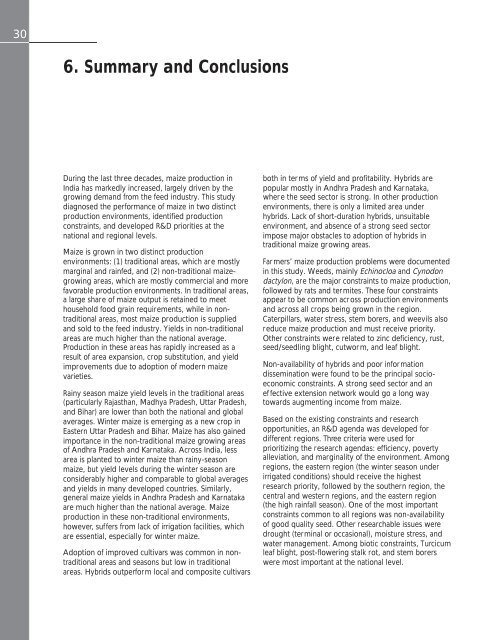Maize in India: Production Systems, Constraints - AgEcon Search
Maize in India: Production Systems, Constraints - AgEcon Search
Maize in India: Production Systems, Constraints - AgEcon Search
You also want an ePaper? Increase the reach of your titles
YUMPU automatically turns print PDFs into web optimized ePapers that Google loves.
30<br />
6. Summary and Conclusions<br />
Dur<strong>in</strong>g the last three decades, maize production <strong>in</strong><br />
<strong>India</strong> has markedly <strong>in</strong>creased, largely driven by the<br />
grow<strong>in</strong>g demand from the feed <strong>in</strong>dustry. This study<br />
diagnosed the performance of maize <strong>in</strong> two dist<strong>in</strong>ct<br />
production environments, identified production<br />
constra<strong>in</strong>ts, and developed R&D priorities at the<br />
national and regional levels.<br />
<strong>Maize</strong> is grown <strong>in</strong> two dist<strong>in</strong>ct production<br />
environments: (1) traditional areas, which are mostly<br />
marg<strong>in</strong>al and ra<strong>in</strong>fed, and (2) non-traditional maizegrow<strong>in</strong>g<br />
areas, which are mostly commercial and more<br />
favorable production environments. In traditional areas,<br />
a large share of maize output is reta<strong>in</strong>ed to meet<br />
household food gra<strong>in</strong> requirements, while <strong>in</strong> nontraditional<br />
areas, most maize production is supplied<br />
and sold to the feed <strong>in</strong>dustry. Yields <strong>in</strong> non-traditional<br />
areas are much higher than the national average.<br />
<strong>Production</strong> <strong>in</strong> these areas has rapidly <strong>in</strong>creased as a<br />
result of area expansion, crop substitution, and yield<br />
improvements due to adoption of modern maize<br />
varieties.<br />
Ra<strong>in</strong>y season maize yield levels <strong>in</strong> the traditional areas<br />
(particularly Rajasthan, Madhya Pradesh, Uttar Pradesh,<br />
and Bihar) are lower than both the national and global<br />
averages. W<strong>in</strong>ter maize is emerg<strong>in</strong>g as a new crop <strong>in</strong><br />
Eastern Uttar Pradesh and Bihar. <strong>Maize</strong> has also ga<strong>in</strong>ed<br />
importance <strong>in</strong> the non-traditional maize grow<strong>in</strong>g areas<br />
of Andhra Pradesh and Karnataka. Across <strong>India</strong>, less<br />
area is planted to w<strong>in</strong>ter maize than ra<strong>in</strong>y-season<br />
maize, but yield levels dur<strong>in</strong>g the w<strong>in</strong>ter season are<br />
considerably higher and comparable to global averages<br />
and yields <strong>in</strong> many developed countries. Similarly,<br />
general maize yields <strong>in</strong> Andhra Pradesh and Karnataka<br />
are much higher than the national average. <strong>Maize</strong><br />
production <strong>in</strong> these non-traditional environments,<br />
however, suffers from lack of irrigation facilities, which<br />
are essential, especially for w<strong>in</strong>ter maize.<br />
Adoption of improved cultivars was common <strong>in</strong> nontraditional<br />
areas and seasons but low <strong>in</strong> traditional<br />
areas. Hybrids outperform local and composite cultivars<br />
both <strong>in</strong> terms of yield and profitability. Hybrids are<br />
popular mostly <strong>in</strong> Andhra Pradesh and Karnataka,<br />
wher e the seed sector is strong. In other production<br />
environments, there is only a limited area under<br />
hybrids. Lack of short-duration hybrids, unsuitable<br />
environment, and absence of a strong seed sector<br />
impose major obstacles to adoption of hybrids <strong>in</strong><br />
traditional maize grow<strong>in</strong>g areas.<br />
Far mers’ maize production problems were documented<br />
<strong>in</strong> this study. Weeds, ma<strong>in</strong>ly Ech<strong>in</strong>ocloa and Cynodon<br />
dactylon, are the major constra<strong>in</strong>ts to maize production,<br />
followed by rats and termites. These four constra<strong>in</strong>ts<br />
appear to be common acr oss production environments<br />
and across all crops be<strong>in</strong>g grown <strong>in</strong> the region.<br />
Caterpillars, water stress, stem borers, and weevils also<br />
reduce maize production and must receive priority.<br />
Other constra<strong>in</strong>ts were related to z<strong>in</strong>c deficiency, rust,<br />
seed/seedl<strong>in</strong>g blight, cutwor m, and leaf blight.<br />
Non-availability of hybrids and poor <strong>in</strong>formation<br />
dissem<strong>in</strong>ation were found to be the pr<strong>in</strong>cipal socioeconomic<br />
constra<strong>in</strong>ts. A strong seed sector and an<br />
ef fective extension network would go a long way<br />
towards augment<strong>in</strong>g <strong>in</strong>come from maize.<br />
Based on the exist<strong>in</strong>g constra<strong>in</strong>ts and research<br />
opportunities, an R&D agenda was developed for<br />
different regions. Three criteria were used for<br />
prioritiz<strong>in</strong>g the research agendas: efficiency, poverty<br />
alleviation, and marg<strong>in</strong>ality of the environment. Among<br />
regions, the eastern region (the w<strong>in</strong>ter season under<br />
irrigated conditions) should receive the highest<br />
research priority, followed by the southern region, the<br />
central and western regions, and the eastern region<br />
(the high ra<strong>in</strong>fall season). One of the most important<br />
constra<strong>in</strong>ts common to all regions was non-availability<br />
of good quality seed. Other researchable issues were<br />
drought (term<strong>in</strong>al or occasional), moisture stress, and<br />
water management. Among biotic constra<strong>in</strong>ts, Turcicum<br />
leaf blight, post-flower<strong>in</strong>g stalk rot, and stem borers<br />
were most important at the national level.

















